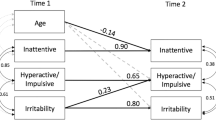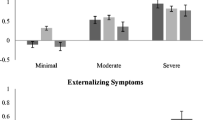Abstract
This study focused on the personality characteristics associated with Attention-deficit/Hyperactivity disorder (ADHD) in a longitudinal sample of youth, with a particular focus on differences between those with and without persisting ADHD symptoms. Participants with ADHD (n = 90) were initially evaluated when they were 7–11 years old, and re-assessed at 16–22 years of age. Matched control subjects (n = 80) were recruited at the time of the follow-up evaluation. At follow-up, the Kiddie-SADS-PL, a semi-structured psychiatric interview, and the NEO-PI, a self-report personality inventory, were administered. Data were analyzed using multivariate analyses of variance (MANOVA). Results indicate that childhood ADHD is associated with lower scores on the NEO Conscientiousness subscale in adolescents/young adults—irrespective of the degree of ADHD persistence. In contrast, ratings of Neuroticism and Agreeableness appear to be more closely linked to adolescent status; those with persisting symptoms only exhibited increased Neuroticism and decreased Agreeableness. These results suggest that ADHD, and the degree to which symptoms persist into adolescence, may be closely linked to personality structure.
Similar content being viewed by others
References
Achenbach, T. M. (1991). Integrative guide for the 1991 CBCL/4-18, YSR, and TRF profiles. Burlington, VT: University of Vermont, Department of Psychiatry.
Bagby, R. M., Levitan, R. D., Kennedy, S. H., Levitt, A. J., & Joffee, R. T. (1999). Selective alteration of personality in response to noradrenergic and serontonergic antidepressant medication in depressed sample: Evidence of nonspecificity. Psychiatry Research, 30, 211–216.
Barkley, R. A., Fischer, M., Smallish, L., & Fletcher, K. (2002). The persistence of attention-deficit/hyperactivity disorder into young adulthood as a functioning of reporting sources and definition of disorder. Journal of Abnormal Psychology, 111, 279–289.
Barkley, R. A., Murphy, K., & Kwasnik, D. (1996). Psychological adjustment and adaptive impairments in young adults with ADHD. Journal of Attention Disorders, 1, 41–54.
Biederman, J., Faraone, S., Milberger, S., Curtis, S., Chen, L., Marrs, S., et al. (1996). Predictors of persistence and remission of ADHD into adolescence: Results from a four-year prospective follow-up study. Journal of the American Academy of Child and Adolescent Psychiatry, 35, 343–351.
Braaten, E. B., & Rosen, L. A. (1997). Emotional reactions in adults with symptoms of attention deficit hyperactivity disorder. Personality and Individual Differences, 22, 355–361.
Costa, P. T., & McCrae, R. R. (1988). Personality in adulthood: A six-year longitudinal study of self-reports and spouse ratings on the NEO Personality Inventory. Journal of Personality and Social Psychology, 54, 853–863.
Costa, P. T., & McCrae, R. R. (1992). NEO PI-R Professional Manual. Odessa, FL: Psychological Assessment Resources.
De Fruyt, F., Mervielde, I., Hoekstra, H. A., & Rolland, J. P. (2000). Assessing adolescents’ personality with the NEO PI-R. Assessment, 7, 329–345.
Digman, J. M. (1997). Higher-order factors of the Big Five. Journal of Personality and Social Psychology, 73, 1246–1256.
Eakin, L., Minde, K., Hechtman, L., Ochs, E., Krane, E., Bouffard, R., et al. (2004). The marital and family functioning of adults with ADHD and their spouses. Journal of Attention Disorders, 8, 1–10.
Fagan, P. J., Wise, T. N., Schmidt, C. W., Ponticas, Y., Marshall, R. D., & Costa, P. T. (1991). A comparison of five-factor personality dimensions in males with sexual dysfunction and males with paraphilia. Journal of Personality Assessment, 57, 434–448.
Faraone, S. V., Biederman, J., Spencer, T., Wilens, T., Seidman, L. J., Mick, E., et al. (2000). Attention-deficit/hyperactivity disorder in adults: An overview. Biological Psychiatry, 48, 9–20.
Gittelman, R., Mannuzza, S., Shenker, R., & Bonagura, N. (1985). Hyperactive boys almost grown up. I. Psychiatric status. Archives of General Psychiatry, 42, 937–947.
Gray, J. R., Burgess, G. C., Schaefer, A., Yarkoni, T., Laresen, R., & Braver, T. S. (2005). Affective personality differences in neural processing efficiency confirmed using fMRI. Cognitive, Affective, and Behavioral Neuroscience, 5, 182–190.
Graydanus, D. E., Sloane, M. A., & Rappley, M. D. (2002). Psychopharmacology of ADHD in adolescents. Adolescent Medicine, 13, 599–624.
Heijtz, R. D., Kolb, B., & Forssberg, H. (2007). Motor inhibitory role of dopamine D1 receptors: Implications for ADHD. Physiology and Behavior (in press).
Holm, S. (1979). A simple sequentially rejective multiple test procedure. Scandinavian Journal of Statistics, 6, 65–70.
Jang, K. L., Livesley, W. J., Ando, J., Yamagata, S., Suzuki, A., Angleitner, A., et al. (2006). Behavioral genetics of the higher-order factors of the Big Five. Personality and Individual Differences, 41, 261–272.
Jensen, P. S., Hinshaw, S. P., Kraemer, H. C., Lenora, N., Newcorn, J. H., Abikoff, H. B. et al. (2001). ADHD comorbidity findings from the MTA study: Comparing comorbid subgroups. Journal of the American Academy of Child and Adolescent Psychiatry, 40, 147–158.
Jensen, P. S., & Kenny, D. T. (2004). The effects of yoga on the attention and behavior of boys with attention-deficit/hyperactivity disorder (ADHD). Journal of Attention Disorders, 7, 205–216.
John, O. P., Caspi, A., Robins, R. W., Moffitt, T., & Stouthamer-Loeber, M. (1994). The “Little Five”: Exploring the nomological network of the Five-Factor model of personality in adolescent boys. Child Development, 65, 160–178.
Khan, S. A., & Faraone, S. V. (2006). The genetics of ADHD: A literature review of 2005. Current Psychiatry Reports, 8, 393–397.
Kaufman, J., Birmaher, B., Brent, D., Rao, U., Flynn, C., Moreci, P, et al. (1997). Schedule for Affective Disorders and Schizophrenia for School-age Children—Present and Lifetime Version (K-SADS-PL): Initial reliability and validity data. Journal of the American Academy of Child and Adolescent Psychiatry, 36, 980–988.
Kaufman, J., Brimaher, B., Brent, D., Rao, U., & Ryan, N. (1996). Kiddie-SADS—Present and lifetime version. Pittsburgh, PA: University of Pittsburgh School of Medicine.
Kraemer, H. C., Measelle, J. R., Ablow, J. C., Essex, M. J., Boyce, W. T., Kupfer, D. J. (2003). A new approach to integrating data from multiple informants in psychiatric assessment and research: Mixing and matching contexts and perspectives. American Journal of Psychiatry, 160, 1566–1577.
Loney, J., & Milich, R. (1982). Hyperactivity, inattention, and aggression in clinical practice. Advances in Developmental and Behavioral Pediatrics, 3, 113–121.
Mannuzza, S., Klein, R. G., Klein, D. F., Bessler, A., & Shrout, P. (2002). Accuracy of adult recall of childhood attention deficit hyperactivity disorder. American Journal of Psychiatry, 159, 1882–1888.
Marks, D. J., Newcorn, J. H., & Halperin, J. M. (2001). Comorbidity in adults with Attention-deficit/Hyperactivity Disorder. Annals of the New York Academy of the Sciences, 931, 216–238.
McCrae, R. R., & Costa, P. T. (1987). Validation of the five-factor model of personality across instruments and observers. Journal of Personality and Social Psychology, 52, 81–90.
McGrath, A. M., Handwerk, M. L., Armstrong, K. J., Lucas, C. P. & Friman, P. C. (2004). The validity of the ADHD section of the Diagnostic Interview Schedule for Children. Behavior Modification, 28, 349–374.
Murphy, K., & Barkley, R. A. (1996). Attention deficit hyperactivity disorder adults: Comorbidity and adaptive impairments. Comprehensive Psychiatry, 37, 393–401.
Nakao, K., & Treas, J. (1994). Updating occupational prestige and socioeconomic scores: How the new measures measure up. Sociological Methodology, 24, 1–72.
Nigg, J. T., Goldsmith, H. H., & Sachek, J. (2004). Temperament and attention deficit hyperactivity disorder: The development of a multiple pathway model. Journal of Clinical Child and Adolescent Psychology, 33, 42–53.
Nigg, J. T., John, O. P., Blaskey, L. G., Huang-Pollack, C. L., Willcutt, E. G., Hinshaw, S. P., et al. (2002). Big five dimensions and ADHD symptoms: Links between personality traits and clinical symptoms. Journal of Personality and Social Psychology, 83, 451–469.
Parker, J. D. A., Majeski, S. A., & Collin, T. (2004). ADHD symptoms and personality: Relationships with the five-factor model. Personality and Individual Differences, 36, 977–987.
Pelham, W. E., Milich, R., Murphy, D. A., & Murphy, H. A. (1989). Normative data on the IOWA Conners Teacher Rating Scale. Journal of Clinical Child Psychology, 18, 259–262.
Pelkonen, M., Marttunen, M., Laippala, P., Lonngvist, J., & Aro, H. (1997). Psychosocial functioning in adolescent psychiatric patients: A prospective study of changes in psychosocial functioning among severely and moderately impaired adolescent outpatients. Acta Psychiatrica Schandinavica, 96, 217–224.
Plizska, S. R. (2007) Pharmacologic treatment of attention-deficit/hyperactivity disorder: Efficacy, safety, and mechanisms of action. Neuropsychology Review, 17, 61–72.
Ranseen, J. D., Campbell, D. A., & Baer, R. A. (1998). NEO PI-R profiles of adults with attention deficit disorder. Assessment, 5, 19–24.
Reuter, M., Schmitz, A., Corr, P., & Hennig, J. (2006). Molecular genetics support Gray’s personality theory: The interaction of COMT and DRD2 polymorphisms predicts the behavioural approach system. International Journal of Neuropsychopharmacology, 9, 155–166.
Robins, R. W., John, O. P., & Caspi, A. (1994). Major dimensions of personality in early adolescence: The Big Five and beyond. In C. F. Halverson, G. A. Kohnstamm, & R. P. Martin (Eds.), The developing structure of temperament and personality from infancy to adulthood (pp. 267–291). Hillsdale, NJ: Lawrence Erlbaum.
Rusch, N., Weber, M., Il’yasov, K. A., Lieb, K., Ebert, D., Hennig, J., et al. (2007). Inferior frontal white matter microstructure and patterns of psychopathology in women with borderline personality disorder and comorbid attention-deficit hyperactivity disorder. Neuroimaging, 35, 738–747.
Shaffer, D., Fisher, P., Piancentini, J., Schwab-Stone, M., & Wicks, J. (1989). Diagnostic Interview Schedule for Children (DISC-2.1P)-Parent Version. New York, NY: New York State Psychiatric Institute.
Shiner, R. L., Masten, A. S., & Roberts, J. M. (2004). Childhood personality foreshadows adult personality and life outcomes two decades later: Erratum. Journal of Personality, 72, 223.
Sonuga-Barke, E. J., Dalen, L., & Remington, B. (2003). Do executive deficit and delay aversion make independent contributions to preschool attention-deficit/hyperactivity disorder symptoms? Journal of the American Academy of Child and Adolescent Psychiatry, 42, 1335–1342.
Spencer, T. J., Biederman, J., Madreas, B. K., Dougherty, D. D., Bonad, A. A., Livni, E., et al. (2007). Further evidence of dopamine transporter dysregulation in ADHD: A controlled PET imaging study using altropane. Biological Psychiatry (2007).
Staller, J. A., & Faraone, S. V. (2007). Targeting the dopamine system in the treatment of attention-deficit/hyperactivity disorder. Expert Review Neurotherapy, 7, 351–362.
van’t Ent, D., Lehn, H., Derks, E. M., Hudziak, J. J., Van Strien, N. M., Veltman, D. J., et al. (2007). A structural MRI study in monozygotic twins concordant or discordant for attention/hyperactivity problems: Evidence for genetic and environmental heterogeneity in the developing brain. Neuroimaging, 35, 1004–1020.
Acknowledgment
This research was supported by NIMH grant no. RO1 MH60698.
Author information
Authors and Affiliations
Corresponding author
Rights and permissions
About this article
Cite this article
Miller, C.J., Miller, S.R., Newcorn, J.H. et al. Personality Characteristics Associated with Persistent ADHD in Late Adolescence. J Abnorm Child Psychol 36, 165–173 (2008). https://doi.org/10.1007/s10802-007-9167-7
Received:
Accepted:
Published:
Issue Date:
DOI: https://doi.org/10.1007/s10802-007-9167-7




